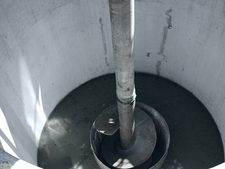Drilling for the exploration of the new recovery shaft near Asse mine started

![]() Drilling for new shaft 5 started – View into bore hole
Drilling for new shaft 5 started – View into bore hole
The first exploratory drilling for the planned new recovery shaft (shaft 5) near the Asse mine started on 5 June 2013. With the help of the drilling the geology of the rock formations will be explored up to a depth of around 790 metres. The objective is to find out whether the site is suitable for another shaft to be drilled and to collect additional data about the geo-scientific structure of the Asse mine.
Should the exploratory drillings show positive results, this location could be the site for the recovery shaft over which the waste is to be recovered from the Asse mine. Currently, retrieving the waste is the only option with the help of which the legally demanded long-term safety can be achieved. This option is therefore laid down in the new "Lex Asse" as the option to be pursued for the decommissioning of the mine.
Purpose of the new shaft
The new shaft 5 is required for retrieving the waste from the Asse mine later on, the previously existing shaft 2 not being sufficient and designed for this purpose. Apart from this main shaft 2, the Asse mine does currently have only one mine shaft that serves for evacuation purposes in the event of an emergency. Over this shaft, only three persons can be hoisted simultaneously from the mine. Furthermore, through constructing a new shaft more staff can work in the mine at the same time.
The planned construction of shaft 5 has also been accelerated by the new "Lex Asse" which has been effective for some weeks now. Among other things, the law permits making investments for the new shafts, parallel to other works, although no nuclear licensing procedure for retrieving the waste from the Asse mine has been carried out so far.
Exploratory drilling to provide findings on geology
The drilling, which started today, explores the underground from the surface. More underground drillings are carried out, whose purpose is also to find evidence for the suitability of the salt rock in the depth of the new shaft connections. It is necessary to carry out exploratory drillings before sinking a new shaft, in order to gain knowledge of the respective geological features and to plan the construction.
In terms of the salt structure of the Asse mine, special care needs to be taken. Two of the originally existing four shafts, shafts 1 and 3, have drowned. Problems with water inflows also occurred when shaft 2 was constructed.
Site selection
The site that is now being explored had been selected previously, after several factors that are decisive for successful shaft sinking had been considered and balanced. The new shaft can only be constructed at a location where there are no old cavities in the underground. It is also essential that it will not be constructed in slightly soluble potash salt. Additionally, safety distances to certain rock layers, such as the Rötanhydrit at the southern flank, need to be kept, the reason for this being that no new locations will generate where saline solutions flow into the mine.
The same applies to anhydrite layers in the northern flank of the Asse mountain saddle. A sufficient safety distance also needs be kept to the existing chambers and galleries.
The drilling site is located approximately 500 metres to the east of the existing main shaft 2. Preparatory works for the drilling have been carried out since November 2012. After the rural district had granted a licence for the site without undue delay, although it is situated in a FFH area, the terrain was initially levelled and tarred, followed by a road connection and setting-up of the drilling site.

